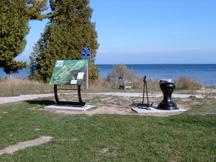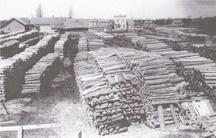Jon Paul’s Maritime Diaries
- Share
- Tweet
- Pin
- Share

The Maritime Trail Marker from the Wisconsin Historical Society at Jacksonport marks the site of the sunken schooners Cecelia and Perry Hanna. The capstain at right was recovered from an unknown wreck just north of the park. Photo by Jon Paul Van Harpen.
In the last column about the schooner Fleetwing, I talked about my early days diving in Door County but my first scuba dive on a shipwreck was at Jacksonport. Like the Fleetwing the shipwrecks at Jacksonport enjoy good public access. Lakeside Town Park has always been a favorite place of mine in Door County. Although the beach has changed significantly in the last few years it is still a great place to have a picnic, beach comb and relax. When I made my first dive on the shipwrecks there back in early 1970s I had little idea about the history of the place or the schooners I was diving on. The ever-shifting sands expose and cover the wrecks yearly so it is always interesting to explore. The old Reynolds Pier looms like an underwater forest and just to the right of the pier are two old schooners which are broken up by the constant wave and ice flows of the area. But on a nice summer day the visibility is very good and it is a shallow dive or snorkel – a great place for the novice or new underwater explorer.
Back then little was written about this old lumber port and it was not until 1990 when the Door County Maritime Heritage Society decided to do a survey of the area that I realized the wonderful history behind the small community.

The Reynolds Pier diagonal with the two shipwrecked schooners, lower right. Photo by Jon Paul Van Harpen.
The first Euro-American to settle in the area was Perry G. Hibbard in 1858. He had come from North Port and was engaged in the fishing business and settled in the area of Hibbard Creek, which is named after him. But it was in 1867 that three men formed a lumber company and purchased large land contracts in the area. The father of the plan was Andrew Jackson who was in charge of the land office in Menasha. He along with Charles L. Harris and John Reynolds made an initial investment of $14,000 although none of the money was from Jackson. They had purchased property from Hibbard to construct a pier and by 1869 both Hibbard and the land company had constructed piers. That same year the town was incorporated and named after the father of the plan, Andrew Jackson. That first year 80 vessels loaded wood at Jacksonport and the sawmill there had turned out 350,000 cedar posts, 25,000 railroad ties, 2,000 telegraph poles, 2,000 cords of wood and 2,000,000 feet of lumber along with 100 barrels of fish. Lumbering in the area would continue for 50 years.
Over the years about a dozen shipwrecks occurred at Jacksonport but all except four were released. The two in front of the park are the Perry Hanna and Cecelia that sank in 1880 and 1885.

The banking grounds at Jacksonport. This is what Lakeside Town Park would have looked like at the turn of the 19th century. Photo by Fred Erskine, courtesy Mrs. Stanley Hein.
The Perry Hannah was built in 1859 at Newport, Michigan by Thomas G. Arnold. She was built for Charles F. Gray under the lease of Hannah, Lay and Company of Traverse City, Michigan, Perry Hannah being one of the owners in that company. She first arrived in Traverse City on May 8, 1859, fresh from her launching on the St. Clair River in April. She was two-masted, 98-feet 8-inches long, 25-feet 2-inches in breadth with a cargo hold depth of 6-feet 7-inches and of 210 tons. She was rebuilt in Chicago in 1862 and lengthened to 125-feet by 26-feet by 10.5-feet. She was a frequent visitor to Jacksonport for a number of years but the big Alpena Blow of October 16, 1880 would bring an end to the Perry Hannah after 21 years of service on the Lakes. The Hanna had just finished loading at Jacksonport and was riding anchor just offshore when the storm hit, she dragged anchor and hit the Reynolds Pier so hard as to break her keel.
The second vessel that sank by the pier was the Cecilia, which was originally built as a barque in 1868 at White Lake, Michigan by Gregory. She had three masts and was 118.2 feet in length, 25.7 feet in width and had a cargo hold depth of 8.4 feet, and of 175.82 gross tons. Her first owner was J. Larsen, who was also captain. The rig was changed in 1879 to a schooner. She wrecked in a storm on September 8, 1885. Her last owner was John Long of Chicago and she was captained by B. R. Smith, who also had shares in the ship. Like the Hanna she was also driven into the pier during a storm.
